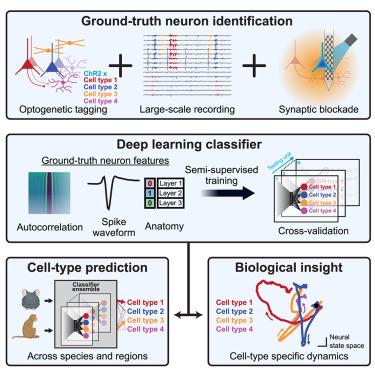A deep learning strategy to identify cell types across species from high-density extracellular recordings
IF 45.5
1区 生物学
Q1 BIOCHEMISTRY & MOLECULAR BIOLOGY
引用次数: 0
Abstract
High-density probes allow electrophysiological recordings from many neurons simultaneously across entire brain circuits but fail to reveal cell type. Here, we develop a strategy to identify cell types from extracellular recordings in awake animals and reveal the computational roles of neurons with distinct functional, molecular, and anatomical properties. We combine optogenetics and pharmacology using the cerebellum as a testbed to generate a curated ground-truth library of electrophysiological properties for Purkinje cells, molecular layer interneurons, Golgi cells, and mossy fibers. We train a semi-supervised deep learning classifier that predicts cell types with greater than 95% accuracy based on the waveform, discharge statistics, and layer of the recorded neuron. The classifier’s predictions agree with expert classification on recordings using different probes, in different laboratories, from functionally distinct cerebellar regions, and across species. Our classifier extends the power of modern dynamical systems analyses by revealing the unique contributions of simultaneously recorded cell types during behavior.

从高密度细胞外记录中识别跨物种细胞类型的深度学习策略
高密度探针允许在整个脑回路中同时记录许多神经元的电生理记录,但不能显示细胞类型。在这里,我们开发了一种策略,从清醒动物的细胞外记录中识别细胞类型,并揭示具有不同功能,分子和解剖特性的神经元的计算作用。我们将光遗传学和药理学结合起来,以小脑为实验平台,为浦肯野细胞、分子层中间神经元、高尔基细胞和苔藓纤维生成一个精心设计的电生理特性基础库。我们训练了一个半监督深度学习分类器,该分类器基于波形、放电统计和记录神经元的层来预测细胞类型,准确率超过95%。分类器的预测与使用不同探针、在不同实验室、从功能不同的小脑区域和跨物种记录的专家分类一致。我们的分类器通过揭示在行为过程中同时记录的细胞类型的独特贡献,扩展了现代动力系统分析的能力。
本文章由计算机程序翻译,如有差异,请以英文原文为准。
求助全文
约1分钟内获得全文
求助全文
来源期刊

Cell
生物-生化与分子生物学
CiteScore
110.00
自引率
0.80%
发文量
396
审稿时长
2 months
期刊介绍:
Cells is an international, peer-reviewed, open access journal that focuses on cell biology, molecular biology, and biophysics. It is affiliated with several societies, including the Spanish Society for Biochemistry and Molecular Biology (SEBBM), Nordic Autophagy Society (NAS), Spanish Society of Hematology and Hemotherapy (SEHH), and Society for Regenerative Medicine (Russian Federation) (RPO).
The journal publishes research findings of significant importance in various areas of experimental biology, such as cell biology, molecular biology, neuroscience, immunology, virology, microbiology, cancer, human genetics, systems biology, signaling, and disease mechanisms and therapeutics. The primary criterion for considering papers is whether the results contribute to significant conceptual advances or raise thought-provoking questions and hypotheses related to interesting and important biological inquiries.
In addition to primary research articles presented in four formats, Cells also features review and opinion articles in its "leading edge" section, discussing recent research advancements and topics of interest to its wide readership.
 求助内容:
求助内容: 应助结果提醒方式:
应助结果提醒方式:


